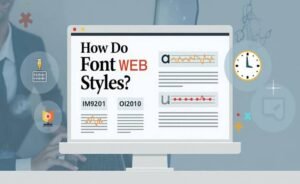which of the following is not a font style? Learn to Spot the Odd One Out

1. Why Are Font Styles Important in Design?
Hey, ever wonder why text looks so good? I’m Text stands out thanks to font styles like bold and italic.
Styles like bold or underline change how text looks. I once confused kerning with styles on a logo—it messed up spacing! The table below explains it.
| Term | Font Style? | What It Does |
| Bold | Yes | Makes text thicker to stand out. |
| Italic | Yes | Slant text for style or focus. |
| Underline | Yes | Puts a line under text. |
| Kerning | No | Changes sthe pace between letters. |
Knowing Out of these, which one is not a font style? helps avoid mistakes. It keeps designs clear. Let’s talk about what font styles are.
2. What Are Font Styles?
What are font styles? They’re things like bold or italic that change text’s look. I’m here to make it simple for you.
Bold, italic, and underline are true styles. Kerning is just spacing, not a style. I mixed them up early on, and it hurt my work.
Spotting Out of these, which one is not a font style? matters. It makes your text clean. Let’s see how styles differ from font families.
3. How Are Font Styles Different from Font Families?
Ever mix up font styles and families? Font families, like Arial, are the main font groups. Styles are changes like bold or italic.
Arial Italic is a style, but kerning sets letter spacing. I learned this while fixing a website’s text. Knowing Out of these, which one is not a font style? helps.
This makes picking design tools easier. It’s a big win. Let’s look at common font styles next.
4. What Are Common Font Styles?
Want to know the top font styles? I use bold, italic, underline, and strikethrough a lot. They add spark to designs.
Bold makes text heavy, italic slants it, and underline adds a line. Kerning is spacing, not a style. Spotting Out of these, which one is not a font style? is key.
Here’s a table to make it clear.
| Feature | Font Style? | What It Does |
| Bold | Yes | Makes text thick for emphasis. |
| Italic | Yes | Slant text for style or focus. |
| Kerning | No | Sets space between letters. |
| Strikethrough | Yes | Puts a line through text. |
This avoids design errors. It keeps things sharp. Let’s check out terms mistaken for styles.
5. What Gets Mixed Up with Font Styles?
Ever hear kerning called a style? I did, and it messed up a client talk! Kerning and tracking are spacing, not styles.
Kerning fixes gaps between letters; tracking sets text spacing. Per Adobe’s guide, knowing Out of these, which one is not a font style? keeps work clean.
Mix-ups look sloppy. Stay sharp for great designs. Let’s talk about font styles in web design.
6. How Do Font Styles Help Web Design?

See how websites make text pop? To draw attention, I utilize bold and italic in CSS. Styles highlight info without switching fonts.
In CSS, font-weight makes bold, font-style sets italic. Kerning uses letter-spacing, not a style. Spotting which of the following is not a font style improves code.
Good styles make sites easy to read. They help users. Let’s talk graphic design next.
7. Why Do Font Styles Matter in Graphic Design?
Ever see a cool poster? To draw attention to myself, I utilize bold, italics, and underlining. They make designs pop.
Kerning and leading set spacing, not style. I over-kerned a flyer once—big mistake! Per Smashing Magazine, knowing which of the following is not a font style helps.
Styles build strong designs. They grab attention. Let’s check print media.
8. How Are Font Styles Used in Print?
Look at a magazine lately? Bold headlines and italic quotes guide you. I use these styles to make the print clear.
Styles highlight text, but kerning sets spacing. Mixing up which of the following is not a font style hurts layouts. Clear styles make print look good.
They improve reading. They make print stand out. Let’s clear up font style myths.
9. What Are Font Style Myths?
Think kerning is a font style? I did too, early on! It’s not—kerning just sets letter spacing.
Another fallacy dispelled is the notion that some typefaces lack bold or italic styles. Errors can be avoided by understanding which of the following is not a font style. It keeps the designs right.
Clearing myths helps your skills. It makes work accurate. Let’s talk about readability.
10. How Do Font Styles Help Reading?
Why is some text easy to read? Bold and italic highlight key points. I use them to make blogs clear.
Too many styles or mistaking kerning for one can clutter text. Knowing which of the following is not a font style keeps text clean. It helps readers.
Good styles make reading easy. They keep people hooked. Let’s look at style tools.
11. What Tools Work for Font Styles?
Need tools for styles? For bold and italic, I utilize Canva and CSS. They make styling text easy.
Kerning is spacing, not a style, in these tools. Knowing which of the following is not a font style saves time. It helps you use the tools correctly.
Good tools make designs clean. They save effort. Let’s wrap up with spotting non-styles.
12. How Can You Spot Non-Font Styles?
Want to find non-font styles fast? Look for what changes text, like bold or italic. Kerning and tracking are just spacing.
I check this in every project for clean text. Design skills improve when you can identify which of the following is not a font style.
This skill lifts your work. It’s a must for pros. Let’s sum it up.
Conclusion
Hey, spotting which of the following is not a font style, like kerning, is key for great text. It boosts your design, web, and print work. Use this to make clear, pro content.
FAQs
Which of the following is not a font style: Times New Roman, Calibri, Right Align, or Arial?
Right Align is not a font style. It moves text to the right but doesn’t change the font.
Which of the following is not a font style: Oblique, Strike-through, Justify, or Bold?
Justify is not a font style. It spreads text evenly across the line.
Which of the following is not a font style: Regular, Bold, Center, or Italic?
Center is not a font style. It places text in the middle but doesn’t change its look.




